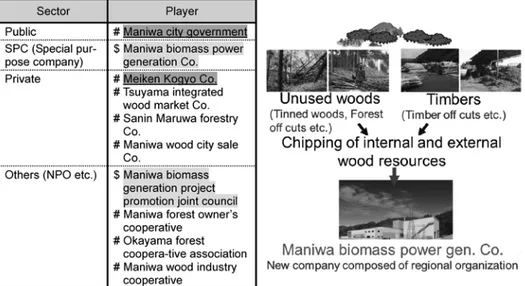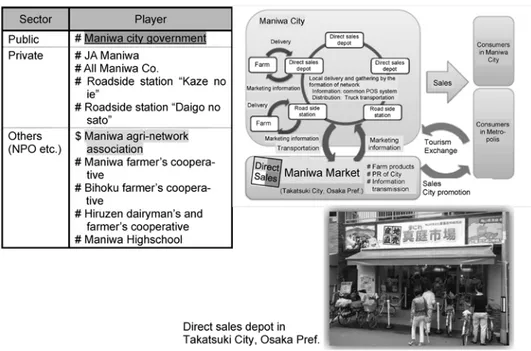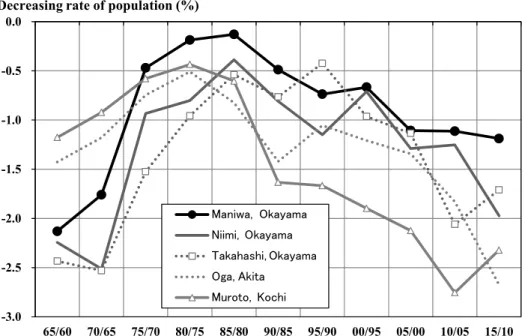An Analysis on the Projects Structure to
Expand Renewable Energy ― A Case Study of the
Maniwa Biomass Project in Japan by Checking
from the Viewpoint of PPP (Public Private
Partnership) ―
著者
Yoshiki Ogawa
journal or
publication title
The Economic Review of Toyo University
volume
43
number
2
page range
187-197
year
2018-03
An Analysis on the Projects Structure to Expand
Renewable Energy
―
A Case Study of the Maniwa Biomass Project in Japan by
Checking from the Viewpoint of PPP (Public Private Partnership) ―
Yoshiki Ogawa
Abstract
After the adoption of UNFCCC in 1992, the expansion of renewable energies has been pursued by planning various regional development projects in Japan. In this paper, we made a case study on the regional development project of Maniwa City in Japan. Because this project has continued during past 24 years step by step, we can definitely say this project is one of successful examples.
First, though the regional development projects in Japan were often made under the leadership of the central governments, they were not always successful. Judging from the case of Maniwa, the participation of local players from the public, private and other sectors and the cooperation among them would be crucial.
Second, the searches and pursuits of local needs would be a quite important task for the regional developments. In the case of Maniwa, this role has been charged by NPO Maniwa circle for the 21st century. The function for local opinion exchanges would be also crucial.
Third, the participation of powerful local companies would be essential to accomplish the projects. In the case of Maniwa, this role has been played by Meiken Kogyo Co., one of local leading company in the wood sector. The participation of local strong company from the private sector would be essential.
Forth, the continuous piling up of various projects step by step over the long period would be required for the successful developments. Because of this, the role of local government such as Maniwa city government and its connection to central government would be also a key factor.
Contents
1 .Introduction 2 .Methods 3 .Results
3 − 1 Historical movements on the Maniwa biomass projects 3 − 2 Recent situations of Maniwa regional developments projects 3 − 3 PPP structure of recent Maniwa regional development projects 3 − 4 Macro Effects induced by Maniwa regional development projects
4 .Concluding remarks References
1 .Introduction
After the adoption of UN framework convention on climate changes (UNFCCC) in 1992, the expansion of renewable energies has been pursued to a great extent by planning various kinds of regional development projects in Japan. In the past 25 years, we have experienced so many happenings and troubles related to the introduction and expansion of renewable energies through these projects.
In December 2015, the Paris agreement on post Kyoto GHGs reduction was finally approved by many countries including various developing countries. In May 2016, Japanese Government has authorized the new target of GHGs reduction to achieve 26% reduction from the emission level in 2013 up to 2030. In addition, Japan need to intensify GHGs reduction measures, because she already committed 50% (or 80%) reduction of GHGs in 2050 in the long-run.
Thus, the expansion of renewable energies related to regional development projects will be one of important options to achieve GHGs reductions in Japan. In this paper, we made a case study on the regional development project in Maniwa City, Okayama Pref. of Japan. Because this project has continued during past 24 years with step by step progresses, we can definitely say this project is one of successful examples in Japan.
2 .Methods
First, we surveyed historical events on the regional development projects in Maniwa city which was focusing local biomass and wood resources. We especially discussed in this study what kinds of biomass projects has been piled up step by step during the past 24 years and also checked how to expand these projects synergistically.
Second, we analysed on the players structure of various biomass projects, respectively. We also discussed who was a key player in order to make these projects successful and what kinds of player s relationship were required for these projects, if judging from the view point of PPP (public and private partnerships).
Third, by checking statistical data such as population and finance in Maniwa city, we analysed the effects brought by the regional developments.
Finally, we summarized several conclusions of this paper.
3 .Results
3 − 1 Historical movements on the Maniwa biomass projects
Maniwa City in Okayama Prefecture is located in the West part of Honshu in Japan as shown in Fig. 1. Maniwa City is in a basin and highland surrounded by Chugoku mountain area and is endowed by rich forest resources. Maniwa City is a typical rural mountain area which is 828 square kirometers.
Ochiai, Yuhara, Kuze and Hokubou Towns and Miama, Kawakami, Yatsutsuka, and Chuka Villages. The population of Maniwa City was 46,714 in August, 2017.
Table 1 shows historical events on the Maniwa biomass projects [1-3]. Maniwa Circle for the 21st century in which local younger people got together and started the discussions on various kinds of regional development projects from 1993, as shown in Table 1. Based on the discussions in this circle, firstly, the eco-friendly power generation using bio fuels was started in 1998. The period during 1993 through 1998 was the preparation stage of regional development projects.
The first stage of regional development projects was the period during 1998 through 2005. In this stage, the industrial cluster plan using woody resources was made in 2001 and the wood chip cement and cat litter were commercialized in 2002. Maniwa Circle for the 21st century got a NPO legal personality also in 2002 and. the Maniwa forum was held in 2003. As described already, Maniwa City started by the merger of nine towns and villages in 2005.
The second stage of regional development projects during 2005 through 2013 started by the merger to Maniwa City. The regional development projects were supported by the NEDO demonstration project adopted in 2005. The Maniwa city biomass town plan was announced in 2006 and Biomass tours Maniwa were started also from 2006. The most important achievement in the second stage was the construction of
Maniwa biomass gathering station in 2009. The utilization of domestic credits system was also started in 2011, as shown in Table. 1.
The third stage (the recent stage) of regional development projects was started from 2013 and continued up to now. The guideline for Maniwa city woody biomass energies utilization and the Maniwa biomass industrial forests and city plan were made in 2013. The most important achievement in this stage was the completion of the large-scale Maniwa biomass power generation plant in 2015.
In the next section, the details of development projects in the recent stage will be discussed. Anyway, based on the discussions in Maniwa Circle for the 21st century , various kinds of development projects such as the eco-friendly power generation, the industrial cluster plan, the commercialization of wood chip cement and cat litter, the biomass town plan and so on has been piled up until now.
3 − 2 Recent situations of Maniwa regional developments projects
As already described in the preceding section, the recent stage of Maniwa regional development projects was started from 2013. Figure 2 shows the whole aspects of the recent stage of Maniwa regional development projects centering Maniwa biomass industrial forests and city plan which was made in 2013.
This plan was composed of the following four projects for commercializetion; (1) the biomass power
generation project, (2) the biomass refinery project, (3) the organic wastes recycle project and (4) the industry tours/related industry expansion and promotion project.
The biomass power generation poject aimed to construct a large-scale woody biomass power plant by using the woody biomass gathering center established in 2009 effectively. The generation capacity of power plant is 10,000 kW and the plant can supply electricity to 22,000 house holds. This project played a center role in the biomass industrial forests and city plan.
In addition to the four projects mentioned above, the recent stage of regional development projects included (5) the agriculture network project and (6) other projects sucha as the Tonbo no Sato (Dragonfly village) project, Yuhara hotspring project etc. These projects were deeply related to (4) the industry tours/ related industry expansion and promotion project.
Maniwa regional development activities have been continued by piling up various projects during the quarter of century. We can definitely say this project is one of successful examples in Japan.
In the next section, as for three projects such as the biomass power generation plant project, the biomass refinery project and the agriculture network project, the detailed structure of PPP (public private partnership) will be discussed individually.
3 − 3 PPP structure of recent Maniwa regional development projects ( 1 ) Biomass power generation project
The PPP structure of biomass power generation plant project is shown in Fig. 3. The players with underline and marking are a key leading one in the project. The players with $ and marking are an organization for linking various players participating to this project. These expressions are common in Figs. 3-5.
The notable characteristics in the players structure are that the local powerful players are joining to the projects from the public and private sectors, respectively. Especially, the role of Maniwa City government and Meiken Kogyo Co. had a quite important role in this project.
Considering from the viewpoint of PPP (public private partnership), the establishment of Maniwa biomass power generation Co. by nine related organization including Meiken Kogyo Co. and Maniwa City government was indispensable. The establishment of Maniwa biomass generation project promotion joint council was also crucial for the linkage of participating players to this project.
Above all else, the participation of Meiken Kogyo Co. to this project should be highlited strongly, because MeikenKogyo Co. is a local company in Maniwa City which has strong international competitiveness in the wood industry sector and is quite powerful in the biomass resouces field.
( 2 ) Biomass refinery project
The PPP structure of biomass refinery project is shown in Fig. 4. In this project, it is noted that one of major players, Maniwa city government supplied the research base called Maniwa Refinary Lab (labolatroy). The participation of the biomass group in the National Institute of Advanced Industrial Science and Technology (AIST) was also specific characteristics in this project.
The major purpose of this project is to develop the future world on the utilization of biomass resources. Therefore, NPO Maniwa circle for the 21st century participated to this project and made large efforts to activate this project. The establishment of Maniwa city biomass refinery promotion committee was crucial for the linkage of participating players to this project, as shown in Fig. 4.
( 3 ) Agriculture network project
The PPP structure of agriculture network project is shown in Fig. 5. The main purpose of this project is to make a usefule network among agricultural producers, sellers of agricultural products and consumers in Maniwa City and the metropolitan area such as Osaka.
(Source) Make by using pictiure and figure cited in References [1] and [4]
For this purpose, direct sales depots and road side stations in Maniwa City are networked and individual farms deliver their agricultural products to this network by providing market information from the network. The consumers in Maniwa City purchase necessary products from direct sales depots or road side stations directly.
This agri-network also tried to make direct sales in the Metropolitan area. For this purpose, the direct sales depot called Maniwa Market was opened in Takatsuki City of Osaka Prefecture, as shown in Fig. 5. The tourism information exchange is included in the role of direct sales depot .
Needless to say, Maniwa city government concentrated her efforts to promote the network making eagerly. The Maniwa agri-network association was also crucial for the linkage of participating players to this project, as shown in Fig. 5.
3−4.Macro Effects induced by Maniwa regional development projects
The regional developments in Maniwa City has been continued during the past 24 years by expanding various biomass and agricultural projects step by step. We also analysed the financial data in Maniwa City [6-7].
The five indicators were selected in order to check the healthy status of local government finance generally from June, 2007 in Japan. The five indicators are as follows; (1) the ratio of actual balance (calculated and checked only a deficit case), (2) the ratio of linked actual balance (calculated and checked only a deficit case),
(3) the ratio of actual debt, (4) the ratio of future burden and (5) the ratio of fund shortage (calculated and checked only a shortage case).
Accompanied with these developments, the finance situations in Maniwa City has been improved and changed to a healthy state, as shown in Fig. 6. Especially, the future burden ratio has been improved drastically. The single actual balance and linked actual balance always showed a positive value and this fact indicates quite healthy finance situations.
In addition, the population decreases in Maniwa City has not been accelerated since 2000, as shown in Fig. 7. The population decreases in Maniwa City could not stop, but the changes in the decreasing rate have been levelled off. This situation is somewhat different to other cities shown in Fig. 7.
It is considered that the vital activities of regional development projects in Maniwa City would indirectly influence to the healthy changes of finance situation in this city and also the mild changes in the decreasing rate of population in this city.
㻓 㻔 㻕 㻖 㻗 㻘 㻙 㻕㻓㻓㻚 㻕㻓㻓㻛 㻕㻓㻓㻜 㻕㻓㻔㻓 㻕㻓㻔㻔 㻕㻓㻔㻕 㻕㻓㻔㻖 㻕㻓㻔㻗 㻕㻓㻔㻘 㻤㼆㼗㼘㼄㼏㼢㼅㼄㼏㼄㼑㼆㼈 㻯㼌㼑㼎㼈㼇㼢㼄㼆㼗㼘㼄㼏㼢㼅㼄㼏㼄㼑㼆㼈 㻋㻥㼢㻼㼈㼑㻌 㻓 㻕㻓 㻗㻓 㻙㻓 㻛㻓 㻔㻓㻓 㻔㻕㻓 㻔㻗㻓 㻔㻙㻓 㻔㻛㻓 㻕㻓㻓㻚 㻕㻓㻓㻛 㻕㻓㻓㻜 㻕㻓㻔㻓 㻕㻓㻔㻔 㻕㻓㻔㻕 㻕㻓㻔㻖 㻕㻓㻔㻗 㻕㻓㻔㻘 㻤㼆㼗㼘㼄㼏㼢㼇㼈㼅㼗㼢㼕㼄㼗㼌㼒 㻩㼘㼗㼘㼕㼈㼢㼅㼘㼕㼇㼈㼑 㼢㼕㼄㼗㼌㼒 㻋㻈㻌
(Source) Maniwa City Government, Announcement on the ratio on healthy finance judgement and fund shortage (from the versions in every year).
4 .Concluding remarks
First, though the regional development projects in Japan were often organized under the leadership of the central governments, they were not always successful. Based on the successful example in Maniwa City, the participation of local players from the public, private and other sectors and the linkage of these local players would be crucial.
Second, the searches and pursuits of local needs would a quite important task for the regional developments. In the regional developments in Maniwa City, this role has been covered by NPO Maniwa circle for the 21st century. The function for local opinion exchanges would be also crucial.
Third, the participation of powerful local companies would be essential to accomplish the regional development projects. In the case of Maniwa City, this role has been played by Meiken Kogyo Co., one of local leading company in the wood industry sector.
Forth, the continuous piling up of various projects step by step over the long period would be required for the successful regional developments. Because of this, the role of local government such as Maniwa city government and the connection between local and central government would be also a key factor.
-3.0 -2.5 -2.0 -1.5 -1.0 -0.5 0.0 65/60 70/65 75/70 80/75 85/80 90/85 95/90 00/95 05/00 10/05 15/10 㻰㼄㼑㼌㼚㼄㻏 㼢㻲㼎㼄㼜㼄㼐㼄 㻱㼌㼌㼐㼌㻏 㼢㻲㼎㼄㼜㼄㼐㼄 㻷㼄㼎㼄㼋㼄㼖㼋㼌㻏㼢㻲㼎㼄㼜㼄㼐㼄 㻲㼊㼄㻏㼢㻤㼎㼌㼗㼄 㻰㼘㼕㼒㼗㼒㻏 㼢㻮㼒㼆㼋㼌
Decreasing rate of population (%)
(Source) Ministry of Public Management、Home Affairs、Posts and Telecommunications, National population census, each version (every five years).
References
[1] Maniwa-shi, The Plan of Maniwa Biomass Industrial Forests and City, January 2014. [2] N. Ohta, Regional Strategies Using Regional resources – Centering Biomass, September 2014. [3] Maniwa-shi, The guideline for the Utilization of Woody Biomass Energies in Maniwa City, March 2013.
[4] Maniwa city biomass refinery promotion committee, Main activities, http://www.m-brc. com/activities.html (checked on Jan. 22, 2018).
[5] Maniwa-shi, Maniwa Agri-Network Promotion Council, http://www.maff.go.jp/chushi /nouson/kaseika/pdf/44_jirei. pdf (checked on Jan. 22, 2018).
[6] Maniwa-shi, Closing Account Data of Maniwa City, every year from 2005.
![Table 1 shows historical events on the Maniwa biomass projects [1-3]. “ Maniwa Circle for the 21st century ” in which local younger people got together and started the discussions on various kinds of regional development projects from 1993, as shown](https://thumb-ap.123doks.com/thumbv2/123deta/10030286.1432145/4.773.116.657.200.497/historical-maniwa-biomass-projects-discussions-regional-development-projects.webp)





